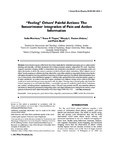“Feeling” others' painful actions: The sensorimotor integration of pain and action information
| dc.contributor.author | Morrison, I | |
| dc.contributor.author | Tipper, SP | |
| dc.contributor.author | Fenton‐Adams, WL | |
| dc.contributor.author | Bach, P | |
| dc.date.accessioned | 2012-05-24T12:15:56Z | |
| dc.date.available | 2012-05-24T12:15:56Z | |
| dc.date.issued | 2013-08 | |
| dc.identifier.issn | 1065-9471 | |
| dc.identifier.issn | 1097-0193 | |
| dc.identifier.uri | http://hdl.handle.net/10026.1/1012 | |
| dc.description.abstract |
<jats:title>Abstract</jats:title><jats:p>Sensorimotor regions of the brain have been implicated in simulation processes such as action understanding and empathy, but their functional role in these processes remains unspecified. We used functional magnetic resonance imaging (fMRI) to demonstrate that postcentral sensorimotor cortex integrates action and object information to derive the sensory outcomes of observed hand–object interactions. When subjects viewed others' hands grasping or withdrawing from objects that were either painful or nonpainful, distinct sensorimotor subregions emerged as showing preferential responses to different aspects of the stimuli: object information (noxious vs. innocuous), action information (grasps vs. withdrawals), and painful action outcomes (painful grasps vs. all other conditions). Activation in the latter region correlated with subjects' ratings of how painful each object would be to touch and their previous experience with the object. Viewing others' painful grasps also biased behavioral responses to actual tactile stimulation, a novel effect not seen for auditory control stimuli. Somatosensory cortices, including primary somatosensory areas 1/3b and 2 and parietal area PF, may therefore subserve somatomotor simulation processes by integrating action and object information to anticipate the sensory consequences of observed hand–object interactions. Hum Brain Mapp, 2013. © 2012 Wiley Periodicals, Inc.</jats:p> | |
| dc.format.extent | 1982-1998 | |
| dc.format.medium | Print-Electronic | |
| dc.language | en | |
| dc.language.iso | eng | |
| dc.publisher | Wiley | |
| dc.subject | action perception | |
| dc.subject | pain observation | |
| dc.subject | empathy | |
| dc.subject | somatosensory | |
| dc.subject | fMRI | |
| dc.subject | tactile discrimination | |
| dc.title | “Feeling” others' painful actions: The sensorimotor integration of pain and action information | |
| dc.type | journal-article | |
| dc.type | Article | |
| plymouth.author-url | https://www.ncbi.nlm.nih.gov/pubmed/22451259 | |
| plymouth.issue | 8 | |
| plymouth.volume | 34 | |
| plymouth.publication-status | Published | |
| plymouth.journal | Human Brain Mapping | |
| dc.identifier.doi | 10.1002/hbm.22040 | |
| plymouth.organisational-group | /Plymouth | |
| plymouth.organisational-group | /Plymouth/REF 2021 Researchers by UoA | |
| plymouth.organisational-group | /Plymouth/REF 2021 Researchers by UoA/UoA04 Psychology, Psychiatry and Neuroscience | |
| plymouth.organisational-group | /Plymouth/Research Groups | |
| plymouth.organisational-group | /Plymouth/Research Groups/Centre for Brain, Cognition and Behaviour (CBCB) | |
| plymouth.organisational-group | /Plymouth/Research Groups/Centre for Brain, Cognition and Behaviour (CBCB)/Brain | |
| dc.publisher.place | United States | |
| dcterms.dateAccepted | 2011-12-20 | |
| dc.identifier.eissn | 1097-0193 | |
| dc.rights.embargoperiod | Not known | |
| rioxxterms.versionofrecord | 10.1002/hbm.22040 | |
| rioxxterms.licenseref.uri | http://www.rioxx.net/licenses/all-rights-reserved | |
| rioxxterms.licenseref.startdate | 2013-08 | |
| rioxxterms.type | Journal Article/Review | |
| plymouth.funder | One step ahead: Prediction of other people's behavior in healthy and autistic individuals.::ESRC |


